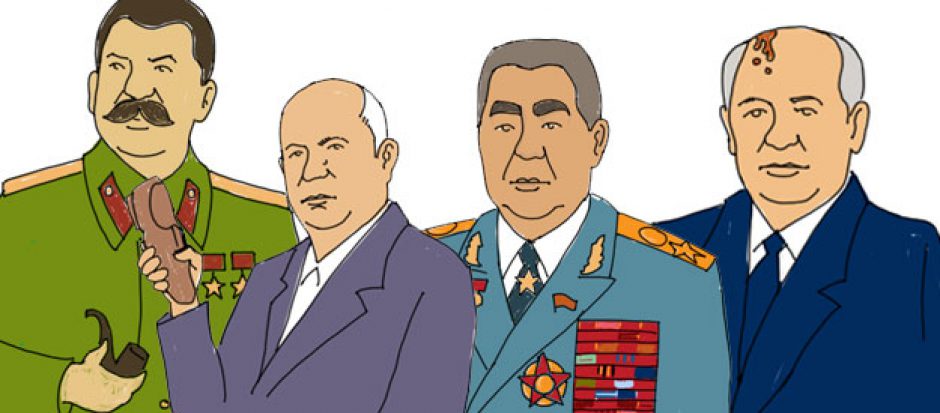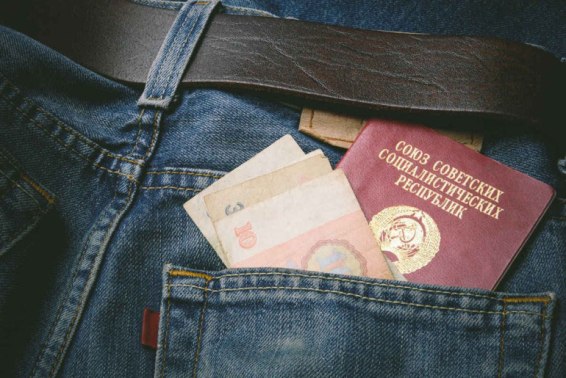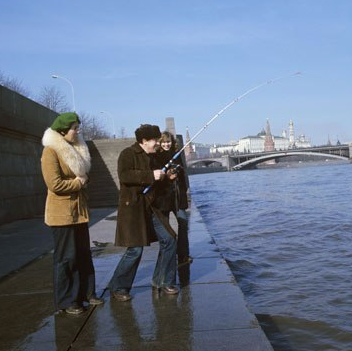Arguably the most significant and impactful event of the Brezhnev era was the legalization of the production of blue jeans (jk). Though many universities and workplaces had previously forbidden the wearing of jeans, the USSR embraced the denim craze, commissioning the companies Levi Strauss, Wrangler, and Lee to manufacture jeans in the Soviet Union in 1979.
This promising deal fell through following the US boycott of the Moscow Olympics, but the USSR’s insatiable desire for denim survived. The Soviet government had begun to manufacture its own competitors to Western brands, however the flood of cheap, Soviet-made denim only made American jeans more desirable to young people. The quality of a young person’s jeans became a symbol of wealth and culture. Most jeans-wearers would have to boil their Soviet jeans in order to imitate the faded color of American jeans. With real American jeans costing as much as a month’s salary, only the rich and well traveled (diplomats, pilots, sailors,etc.) could afford authentic “stateside” jeans.
Denim jeans became the most sought-after commodity on the Soviet black market, and they even increased violent crime. The term “jeans crimes” was coined by law enforcement officials to describe crimes committed in the pursuit of denim, which included even violent attacks and stabbings.
Although blue jeans seem insignificant, they represented all of the problems faced by the USSR throughout the era of stagnation. The authorities struggled to produce sufficient quality jeans, which is representative of the Soviet belief that Western products are more well-made. Their inability to supply an adequate quantity of jeans and the increase of “jeans crimes” was indicative of their wider inability to adequately supply products and nix the black market. Lastly, the youth’s demand for material goods for their fashionability represented a growing dissolutionment of the Soviet system by younger generations. How could the Soviet system be superior if it cannot even compete with the West in the denim race?
The Soviet obsession with American blue jeans were a sign of things to come. They exposed some of the weaknesses of the Soviet systems and the flaws with the government’s representations of the West. The significance of blue jeans are best described by this quote by Russian writer Sergei Boukhonine:
The Soviet TV showed poor people in urban ghettos [in the US]… The Soviet people were supposed to watch and become more confident about the superiority of the socialist system. However, there was a small but crucial problem… you guessed it — blue jeans! All poor urban folks and union marchers wore the coveted blue jeans!!! Even the homeless people in the West wore them. So, the wheels of Soviet minds turned, these people couldn’t be all that poor and miserable if they all wore the pants which we couldn’t afford!




Chris, such a cool topic you chose to write on this week. I had never before read about the denim craze in the Soviet Union so it is interesting to learn that something almost everyone in the U.S. owns was highly coveted by our main competitor overseas. Further, I think the quality of someone’s jeans is still an indicator of wealth today, as a wide variety of companies and brands now exist that can be bought to showcase the status that someone wants to give of themselves. Great work!
LikeLike
I agree with Max – this is a fantastic topic. And I was also going to say that clothes (including jeans) are still social status indicators today. I really enjoyed this post. Great job.
LikeLike
This is a really cool post! I remember hearing a story one time about shoe issues in the Soviet Union where they wouldn’t have a variety of sizes or enough of one foot, one that stood out to me was about a mass production of left shoes but not right. This story reminded me of it. Especially since denim in the US, even shoes, are seen as basic clothing items everyone has. Your blog even points out how the homeless in the US had denim. But the showing off of wealth is also a factor of any item of clothing today. Where some people may pay $10 for jeans, others pay upwards of $200. It’s really rather humorous that something as superficial as jeans caused such a stir. Great post!
LikeLike
Oh this post stirs many memories for me! I was always entranced by the Soviet romance with Levi’s — especially because back then, they were not that expensive here. “Designer jeans” might cost $35, but a regular pair of 501’s was probably only $20 or so? And of course this was all before the lycra revolution — no skinny jeans. Anyway, I was always a purist — loved regular 501’s. I probably went to grad school so I could keep wearing jeans all the time and not have to buy grown-up clothes. ;J And of course when I started going to the Soviet Union there was a lot of interest in my jeans — which I would have gladly sold, or traded for something I really wanted (tailored grey army coat). The problem was the fit — all of my Russian friends were tall.
LikeLike
This is an awesome post! I have never thought jeans could be such a craze that they were sold on the black market. I also think it is crazy that people committed crimes over these jeans! Great job!
LikeLike
Who would have thought people would mug each other over Levi’s. They’re so common in the U.S you would think it wouldn’t be hard to get them. I wonder if they are still popular in Russia today.
LikeLike
Incredibly interesting post! Who would have known that a desire for denim jeans echoed the state of the Soviet Union. So neat.
LikeLike
This is such an interesting topic! I can’t imagine something as simple and commonplace as denim causing rises in crime or being a prize item on the black market. The idea of that is mindblowing. I think you did a great job emphasizing the craziness of this topic as well as how it marked a theme for the Soviet Union at the time.
LikeLike